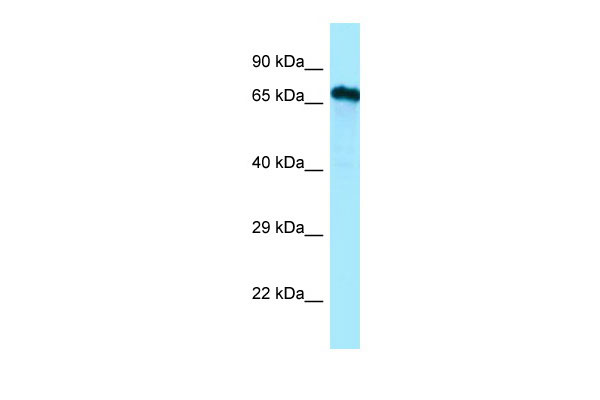CDC14A antibody - C-terminal region
Rabbit Polyclonal Antibody
- SPECIFICATION
- CITATIONS
- PROTOCOLS
- BACKGROUND

Application
| WB |
|---|---|
| Primary Accession | Q9UNH5 |
| Other Accession | NM_003672, NP_003663 |
| Reactivity | Human, Mouse, Rat, Rabbit, Horse, Bovine, Guinea Pig, Dog |
| Predicted | Human, Mouse, Rat, Rabbit, Pig, Horse, Bovine, Guinea Pig, Dog |
| Host | Rabbit |
| Clonality | Polyclonal |
| Calculated MW | 66kDa |
| Gene ID | 8556 |
|---|---|
| Alias Symbol | cdc14, hCDC14 |
| Other Names | Dual specificity protein phosphatase CDC14A, 3.1.3.16, 3.1.3.48, CDC14 cell division cycle 14 homolog A, CDC14A |
| Format | Liquid. Purified antibody supplied in 1x PBS buffer with 0.09% (w/v) sodium azide and 2% sucrose. |
| Reconstitution & Storage | Add 50 ul of distilled water. Final anti-CDC14A antibody concentration is 1 mg/ml in PBS buffer with 2% sucrose. For longer periods of storage, store at 20°C. Avoid repeat freeze-thaw cycles. |
| Precautions | CDC14A antibody - C-terminal region is for research use only and not for use in diagnostic or therapeutic procedures. |
| Name | CDC14A |
|---|---|
| Function | Dual-specificity phosphatase. Required for centrosome separation and productive cytokinesis during cell division. Dephosphorylates SIRT2 around early anaphase. May dephosphorylate the APC subunit FZR1/CDH1, thereby promoting APC-FZR1 dependent degradation of mitotic cyclins and subsequent exit from mitosis. Required for normal hearing (PubMed:29293958). |
| Cellular Location | Nucleus. Cytoplasm, cytoskeleton, microtubule organizing center, centrosome. Cytoplasm, cytoskeleton, spindle pole. Cytoplasm, cytoskeleton, spindle. Cell projection, kinocilium {ECO:0000250|UniProtKB:Q6GQT0}. Cell projection, stereocilium {ECO:0000250|UniProtKB:Q6GQT0}. Note=Centrosomal during interphase, released into the cytoplasm at the onset of mitosis. Subsequently localizes to the mitotic spindle pole and at the central spindle (PubMed:11901424, PubMed:12134069, PubMed:15263015). Present along both the transient kinocilia of developing cochlear hair cells and the persistent kinocilia of vestibular hair cells (By similarity) {ECO:0000250|UniProtKB:Q6GQT0, ECO:0000269|PubMed:11901424, ECO:0000269|PubMed:12134069, ECO:0000269|PubMed:15263015} |

Thousands of laboratories across the world have published research that depended on the performance of antibodies from Abcepta to advance their research. Check out links to articles that cite our products in major peer-reviewed journals, organized by research category.
info@abcepta.com, and receive a free "I Love Antibodies" mug.
Provided below are standard protocols that you may find useful for product applications.
References
Li L.,et al.J. Biol. Chem. 272:29403-29406(1997).
Wong A.K.C.,et al.Genomics 59:248-251(1999).
Hao L.,et al.Submitted (MAY-1998) to the EMBL/GenBank/DDBJ databases.
Belyaev A.S.,et al.Submitted (MAY-2006) to the EMBL/GenBank/DDBJ databases.
Gregory S.G.,et al.Nature 441:315-321(2006).
If you have used an Abcepta product and would like to share how it has performed, please click on the "Submit Review" button and provide the requested information. Our staff will examine and post your review and contact you if needed.
If you have any additional inquiries please email technical services at tech@abcepta.com.













 Foundational characteristics of cancer include proliferation, angiogenesis, migration, evasion of apoptosis, and cellular immortality. Find key markers for these cellular processes and antibodies to detect them.
Foundational characteristics of cancer include proliferation, angiogenesis, migration, evasion of apoptosis, and cellular immortality. Find key markers for these cellular processes and antibodies to detect them. The SUMOplot™ Analysis Program predicts and scores sumoylation sites in your protein. SUMOylation is a post-translational modification involved in various cellular processes, such as nuclear-cytosolic transport, transcriptional regulation, apoptosis, protein stability, response to stress, and progression through the cell cycle.
The SUMOplot™ Analysis Program predicts and scores sumoylation sites in your protein. SUMOylation is a post-translational modification involved in various cellular processes, such as nuclear-cytosolic transport, transcriptional regulation, apoptosis, protein stability, response to stress, and progression through the cell cycle. The Autophagy Receptor Motif Plotter predicts and scores autophagy receptor binding sites in your protein. Identifying proteins connected to this pathway is critical to understanding the role of autophagy in physiological as well as pathological processes such as development, differentiation, neurodegenerative diseases, stress, infection, and cancer.
The Autophagy Receptor Motif Plotter predicts and scores autophagy receptor binding sites in your protein. Identifying proteins connected to this pathway is critical to understanding the role of autophagy in physiological as well as pathological processes such as development, differentiation, neurodegenerative diseases, stress, infection, and cancer.


